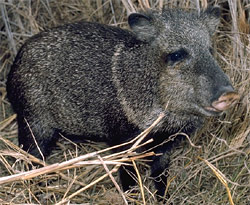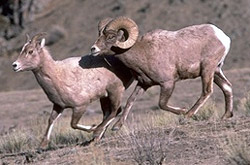



Artiodactyla: More on Morphology
 Collared Peccary. Photo by Dr. Llloyd Glenn Ingles, © 2002 California Academy of Sciences. |
A great many living artiodactyls have evolved features that are adaptive for life on open grasslands. Long legs, for example, increase running speed. To lengthen the legs, hoofed mammals evolved digitigrade locomotion: that is, they walk on their toes. Artiodactyls are characterized by the presence of two enlarged toes forming a cloven hoof; the hoof of a goat or cow is anatomically the enlarged third and fourth toes. Pigs and peccaries may retain two small but well-developed toes to the sides of the third and fourth toes. Most artiodactyls, however, have either highly reduced these extra toes (such as deer) or completely lost them (as in camels). Many artiodactyls also show a tendency for foot bones to fuse:
 Bighorn Sheep. Photo by Gerald and Buff Corsi, © 2000 California Academy of Sciences. |
Pigs and peccaries have simple stomachs and teeth with low, rounded cusps (referred to as bunodont teeth); they also
 Moose. Photo by Gerald and Buff Corsi, © 2002 California Academy of Sciences. |
More advanced artiodactyls, the ruminants, have evolved complex stomachs with three or four chambers. Food (typically grass or other plant material) is swallowed, partially digested and fermented, and then regurgitated for further chewing — "chewing the cud." This allows symbiotic bacteria and protists that live in the stomach to break down tough plant material that would otherwise be indigestible. Correlated with this diet is the evolution of selenodont molar teeth — teeth with crescent-shaped ridges — for more efficient grinding of plants. Ruminants also lack incisors in the upper jaw, and most lack canines in the upper jaw as well.
